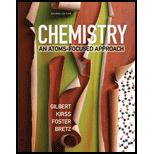
To find:
The rate law and units of the rate constant (by using the units
Answer to Problem 13.49QA
Solution:
a) The reaction of oxygen atoms with
Rate law is
Unit of rate constant is
b) The reaction between
Rate law is
Unit of rate constant is
c) The reaction between
Rate law is
Unit of rate constant is
d) The decomposition of ozone (
Rate law is
Unit of rate constant is
Explanation of Solution
1) Concept:
i. Rate law:
Therefore,
Hence rate law will be,
where
ii. Unit of reaction rate:
Rate is change in concentration per unit time, so the unit for rate is
Here unit for concentration is
.
iii. Unit of rate constant
From equation 1,
Units of rate are
2) Calculations:
a. The reaction of oxygen atoms with
Rate law:
The reaction is first order in both reactants. Therefore, the exponents of concentration of both reactants is 1, and the rate law is:
Units of rate constant
Rearranging the rate law for rate constant, we get:
b. The reaction between
Rate law:
The reaction is second order in
Therefore, the rate law is:
Unit of rate constant
Rearranging this rate law for rate constant, we get:
c. The reaction between
Rate law:
The reaction is first order in
Units of rate constant
Rearranging the rate equation for rate constant, we get:
d. The decomposition of ozone (
Rate law:
The reaction is second order in
Units of rate constant
Rearranging the rate equation for rate constant, we get:
Conclusion:
Rate law determines the relation between the concentration of reactants and the rate of reaction. Order with respect to the reactants is the exponent of each reactant in the rate law.
Want to see more full solutions like this?
Chapter 13 Solutions
CHEMISTRY:ATOMS-FOCUSED..-ACCESS
 ChemistryChemistryISBN:9781305957404Author:Steven S. Zumdahl, Susan A. Zumdahl, Donald J. DeCostePublisher:Cengage Learning
ChemistryChemistryISBN:9781305957404Author:Steven S. Zumdahl, Susan A. Zumdahl, Donald J. DeCostePublisher:Cengage Learning ChemistryChemistryISBN:9781259911156Author:Raymond Chang Dr., Jason Overby ProfessorPublisher:McGraw-Hill Education
ChemistryChemistryISBN:9781259911156Author:Raymond Chang Dr., Jason Overby ProfessorPublisher:McGraw-Hill Education Principles of Instrumental AnalysisChemistryISBN:9781305577213Author:Douglas A. Skoog, F. James Holler, Stanley R. CrouchPublisher:Cengage Learning
Principles of Instrumental AnalysisChemistryISBN:9781305577213Author:Douglas A. Skoog, F. James Holler, Stanley R. CrouchPublisher:Cengage Learning Organic ChemistryChemistryISBN:9780078021558Author:Janice Gorzynski Smith Dr.Publisher:McGraw-Hill Education
Organic ChemistryChemistryISBN:9780078021558Author:Janice Gorzynski Smith Dr.Publisher:McGraw-Hill Education Chemistry: Principles and ReactionsChemistryISBN:9781305079373Author:William L. Masterton, Cecile N. HurleyPublisher:Cengage Learning
Chemistry: Principles and ReactionsChemistryISBN:9781305079373Author:William L. Masterton, Cecile N. HurleyPublisher:Cengage Learning Elementary Principles of Chemical Processes, Bind...ChemistryISBN:9781118431221Author:Richard M. Felder, Ronald W. Rousseau, Lisa G. BullardPublisher:WILEY
Elementary Principles of Chemical Processes, Bind...ChemistryISBN:9781118431221Author:Richard M. Felder, Ronald W. Rousseau, Lisa G. BullardPublisher:WILEY





